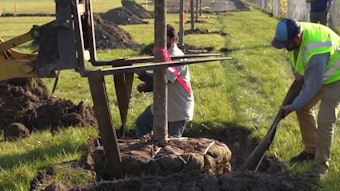If you’ve got stressed-out turf with low nitrogen levels, you’re susceptible to Dollar Spot. And lately, due to colder and wetter conditions in many parts of the country, this infectious fungal disease has become a major problem throughout the growing season for many lawn care operators.
“Dollar Spot has been a bigger problem the last couple of years in both the North and South due to climate and reduced maintenance inputs,” says Jimmy Johnson, fungicide product manager for Bayer Environmental Science. Normally a concern in Bentgrasses, Johnson says Dollar Spot can also become an issue in Fescue/Bluegrass mixes, and Bluegrass itself. “Under low fertility and high moisture with cool nights, Dollar Spot can also infect Bermuda and St. Augustine,” Johnson adds.
Symptoms
Dollar Spot appears as round, somewhat sunken brown or straw-colored spots approximately the size of a silver dollar. Dead spots are larger and more diffuse in course-textured grasses maintained at taller cutting heights. Sometimes infected areas of 4 inches or larger may run together, causing large patches.
Causes
Dollar Spot is caused by a fungal pathogen that blights leaf tissues but does not affect roots or crowns. Historically a problem in the spring when temperatures begin to warm up, strains of this fungi grow within a wide range of temperatures, allowing it to stay active from late spring to late autumn. Still, most problems occur when temperatures are moderately warm and change rapidly—as is the case with warm days and cool nights.
Turfgrass under stress is much more susceptible to infection. Long periods of high humidity may cause severe outbreaks. Turfgrass with low nitrogen levels is also more susceptible. Severe outbreaks of Dollar Spot in residential turf are often the result of poor maintenance practices.
Prevention and Cure
Proper Lawn Management. Mow at proper cutting height and collect clippings when an outbreak is suspected. Be sure to remove heavy layers of thatch. Likewise, regularly aerate the turf with a core-type aerator.
Irrigation. Be careful with watering. First of all, you might be fooled into thinking that Dollar Spot is simply dried-out grass in need of water. But overwatering could make the disease get worse. Furthermore, do not irrigate turf in the late afternoon or evening, since this prolongs leaf wetness and may intensify the disease on cool nights when dew is likely to form.
Fungicides. In hard-hit areas or when disease is recurrent, fungicides labeled for use against dollar spot, such as Bayer’s Bayleton, can help. “Bayleton is available in a granular product that can be spread, or in two sprayable formulations: a liquid flowable and a WP in water-soluble packaging,” Johnson says. “Bayleton FLO is a new liquid formulation recently introduced to the market, and is gaining wide acceptance. Other strengths for Bayleton are broad spectrum control, and preventive fairy ring control.”


























